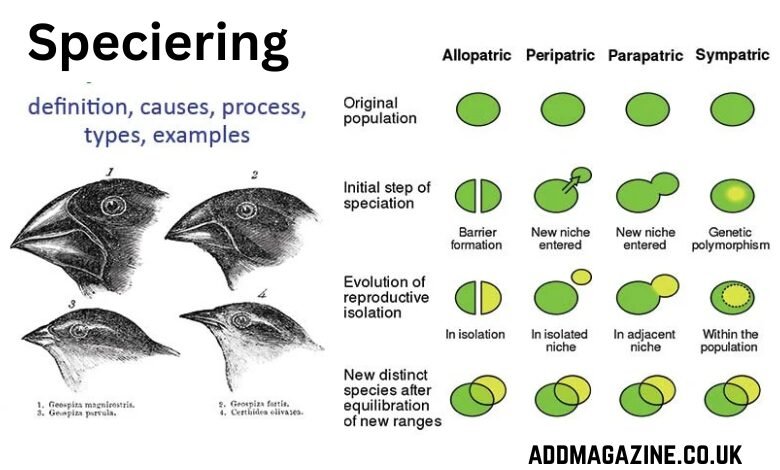Speciering, often known as speciation, refers to the process through which a single species diverges and evolves into multiple distinct species over time. This fascinating phenomenon occurs due to reproductive isolation and genetic changes, allowing new species to emerge. It’s one of the key drivers of biodiversity on Earth, explaining how a diverse array of species arises from a common ancestral population.
In essence, speciering describes the shift from one population to multiple populations that no longer interbreed successfully. Over time, these isolated populations evolve independently and accumulate genetic differences, eventually leading to the formation of entirely new species.
What Drives Speciering?
Speciering is primarily driven by factors that isolate populations, preventing gene flow. These factors could be geographical, ecological, or even behavioral. Let’s break down the core mechanisms that contribute to this process:
- Geographical Isolation: When a population becomes physically separated from the rest of its species due to a geographic barrier, like a river, mountain range, or an ocean, it becomes isolated. Over time, the isolated group experiences different environmental conditions, leading to genetic differences.
- Behavioral Changes: Even without a physical barrier, changes in behavior, such as mating rituals or feeding habits, can lead to reproductive isolation. These changes may prevent two populations from interbreeding, despite living in the same geographic area.
- Ecological Factors: The environment plays a significant role in speciation. If two populations live in different ecological niches—such as different elevations, soil types, or food sources—they may evolve distinct traits that lead to reproductive isolation.
- Genetic Drift and Mutation: In small, isolated populations, genetic drift can have a large impact. Random mutations can accumulate, leading to genetic changes that make populations more distinct from one another. Over time, these mutations can drive substantial shifts in a species’ evolutionary trajectory, leading to significant genetic transformations.
Types of Speciering
There are four main types of speciering, each reflecting the mechanisms by which reproductive isolation occurs:
1. Allopatric Speciering
Allopatric speciering is the most common form. This type of speciation happens when a population is physically divided by a geographical barrier. Once separated, the isolated populations evolve independently, driven by different environmental conditions, genetic mutations, and natural selection pressures.
An example of allopatric speciering is the Darwin’s finches in the Galápagos Islands. These finches were once part of a single population but became separated due to geographic barriers. Over time, they adapted to the different environments on each island, resulting in the development of different species of finches with varied beak shapes and sizes. This adaptation allowed each species to exploit specific food sources on their respective islands.
2. Sympatric Speciering
Sympatric speciering occurs when new species evolve from a single population within the same geographic area. In this case, there is no physical barrier separating the populations. Instead, speciation happens due to ecological factors, behavioral changes, or genetic variations.
A prime example of sympatric speciering is found in cichlid fish in African lakes. These fish have evolved into hundreds of species, despite living in the same bodies of water. They adapted to different ecological niches, such as varying depths and food sources, and over time, reproductive isolation developed due to these ecological and behavioral changes.
3. Parapatric Speciering
Parapatric speciering occurs when two populations live in adjacent, but distinct, environments. While these populations are not fully isolated, their different habitats lead to the development of distinct traits. Over time, these traits may result in reproductive isolation, even if the populations are not entirely separated.
An example of parapatric speciering can be seen in certain species of plants. Some plants grow along the borders of two different habitats, such as a dry area and a wetland. These plants may evolve to adapt to the specific conditions in each environment, leading to differences in appearance, flowering times, or other traits. As these populations diverge, they may no longer interbreed, resulting in speciation.
4. Peripatric Speciering
Peripatric speciering is a form of allopatric speciering that occurs when a small group of individuals from a larger population becomes isolated at the edge of the population’s range. These isolated groups are subjected to unique environmental pressures and genetic shifts, which can accelerate their evolutionary trajectory. Over time, this divergence results in speciation.
An example of peripatric speciering can be seen in some island populations. When a small group of individuals is separated from the main population and colonizes an isolated island, genetic drift and different environmental pressures can cause the population to diverge. This process may give rise to a distinct species, with genetic traits that differentiate it from the original group.
Mechanisms Behind Speciering
There are several key mechanisms that drive speciering. Let’s explore how these factors contribute to the development of new species.
1. Genetic Drift
Genetic drift refers to random changes in gene frequencies within a population. In small, isolated groups, random genetic variations have a greater effect, potentially causing the loss or dominance of specific alleles. As these variations accumulate, genetic divergence between populations becomes more pronounced, driving speciation.
2. Natural Selection
Natural selection plays a crucial role in speciering. As time progresses, populations evolve in response to their surroundings, with beneficial traits that enhance survival and reproduction becoming more prevalent. As populations evolve to suit their specific environments, they may accumulate genetic changes that result in reproductive isolation and speciation.
For example, mating preferences can evolve through natural selection. If individuals in one population develop a preference for certain traits (such as size, color, or behavior), those traits may become more common in the population. If another population develops a different preference, they may no longer interbreed, leading to reproductive isolation and eventually speciation.
3. Reproductive Isolation
Reproductive isolation is the key mechanism that prevents gene flow between populations. There are two main types of reproductive isolation:
- Pre-zygotic isolation: This occurs before fertilization, such as differences in mating behavior, timing, or habitat. If populations no longer recognize each other as mates or mate at different times, they will not interbreed.
- Post-zygotic isolation: This occurs after fertilization, such as when hybrid offspring are sterile (like mules, the offspring of horses and donkeys). Even if two populations interbreed, post-zygotic isolation prevents the production of viable offspring, further reinforcing reproductive isolation.
4. Mutations
Mutations refer to spontaneous alterations in an organism’s genetic code. While most mutations are neutral or harmful, some can be beneficial, contributing to the development of new traits. Mutations play a vital role in generating genetic diversity, and beneficial mutations can be selected for by natural selection, helping populations adapt to their environments. Over time, mutations can accumulate, contributing to the divergence of populations and speciation.
Examples of Speciering in Nature
Several examples from nature highlight the process of speciering in action:
- Darwin’s Finches: The finches of the Galápagos Islands are an iconic example of allopatric speciering. After being geographically isolated on different islands, these finches adapted to the specific conditions of each island. Over time, they evolved distinct beak shapes and sizes, leading to the development of multiple species.
- Cichlid Fish in Africa: The cichlids of Lake Victoria are an example of sympatric speciering. These fish evolved into numerous species despite living in the same lake. Differences in feeding habits, mating behaviors, and environmental niches led to reproductive isolation and the formation of new species.
- Hawthorn Fly: The hawthorn fly is an example of sympatric speciering. Originally, these flies fed on hawthorn trees. However, with the introduction of apple trees, a subset of the population began to feed on apples. As time passed, the two groups became reproductively isolated, eventually resulting in the emergence of separate species.
Conclusion
Speciering is a vital process in the natural world that explains the emergence of new species and the rich diversity of life on Earth. Whether through geographic isolation, ecological pressures, genetic changes, or behavioral shifts, speciering contributes to the continuous evolution of species. Understanding the different types of speciering and the mechanisms that drive them provides valuable insight into the complexity of evolution and the processes that shape biodiversity.
Through examples like Darwin’s finches, cichlid fish, and hawthorn flies, we can see how speciering occurs in various forms and how reproductive isolation plays a crucial role in the creation of new species. By studying these processes, we gain a deeper understanding of how life adapts and diversifies across time and space.




